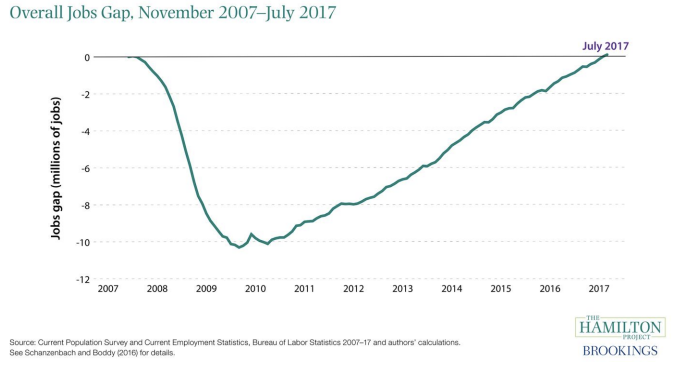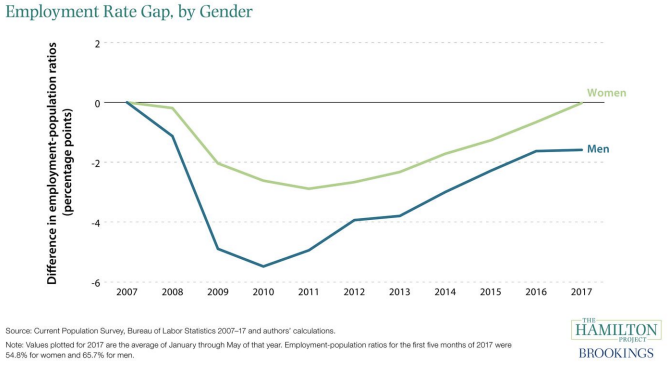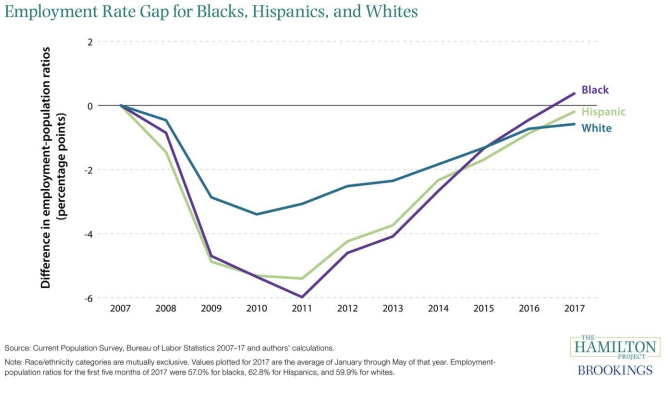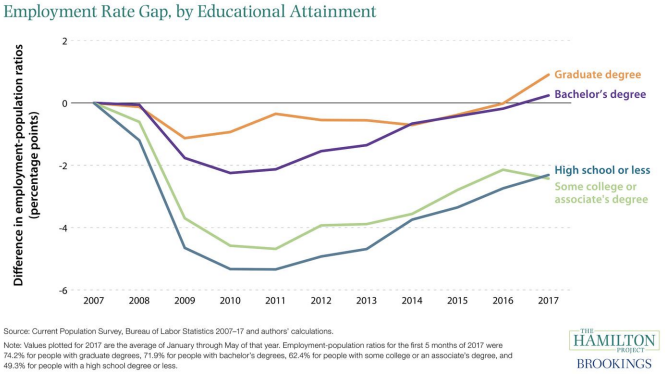The job market hits a key milestone
The last recession ended in 2009, and it took until 2014 for the economy to add back all the jobs lost during the downturn. But accounting for population changes, the proportion of jobs remained below pre-recession levels.
Until now. Employers added 209,000 jobs in July, which pushed the economy past an important milestone: When adjusted for a growing and aging population, there are now more jobs than there were at the pre-recession peak in 2007. “Nearly a full decade after the start of the recession, employment has returned to its demographically adjusted pre-recession level,” according to a new report from the Hamilton Project, which is part of the Brookings Institution. “The economy has added enough jobs to make up for losses during the Great Recession.”
The economy lost about 8.5 million jobs on account of the recession. Since the U.S. population continued to grow during that time, and the age mix shifted, it took about 10 million new jobs to get back to the same level of labor-market health as in November of 2007, right before the recession began. There are still shortcomings in the labor market. But fully closing this “jobs gap” is an important sign of healing.

Some segments remain troubled
The Brookings report points out that even back in 2007, there was slack in the labor market, with some people underemployed and others who might work if good jobs were available not even looking for work. So we’ve returned to a less-than-perfect baseline. And some significant slices of the labor market remain troubled.
Men suffered more during the recession, because male-dominated sectors including construction and manufacturing got hammered. As a consequence, men have not recovered as a bloc of the labor force as well as women have, with a sizable jobs gap for men, compared with 2007 levels.

There are regional variations, too. Fifteen states (including the District of Columbia) have closed the jobs gap, including New England and Midwestern states such as Indiana, Michigan and Wisconsin. But 11 other states still have a sizable jobs gap, including southern ones such as North Carolina and Mississippi along with northern ones such as Montana and Wyoming. This reflects a variety of factors, including disruptions in the energy industry, the impact of technological change and the extent of damage done during the recession.
Blacks and Hispanics suffered more than whites in terms of job losses caused by the recession — but they’ve now recovered slightly better, compared with 2007. Those struggling most during the last 10 years are workers without a college education, who still face a large jobs gap compared with 2007. Many unskilled jobs have been replaced with automation and will probably never return.


President Trump has crowed about job gains during his first six months in office, even though job growth under Trump has continued at the same pace as during President Obama’s second term. The recovery of the last eight years has been the slowest since the end of World War II, but it is grudgingly moving along. Eventually, the labor market may be even healthier than it was in 2007.
Confidential tip line: rickjnewman@yahoo.com. Encrypted communication available.
Read more:
Rick Newman is the author of four books, including Rebounders: How Winners Pivot from Setback to Success. Follow him on Twitter: @rickjnewman


